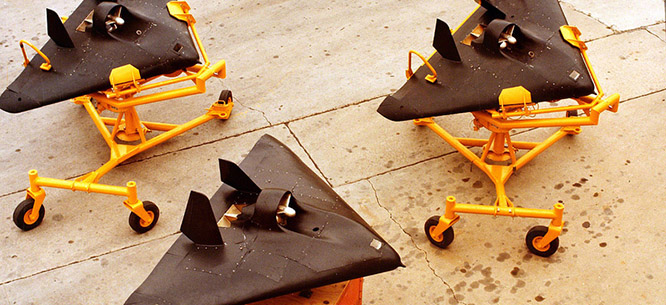Droneism
Droneism
“Is there racism against drones?” asked an audience member at the Drones and Aerial Robotics Conference in New York City last autumn. Drone hobbyists are seeking to divorce their toys from images of war and bloodshed. But even hobbyist drones are the product of extremely powerful institutions with a keen interest in maintaining that power.

“Is there racism against drones?”
The moderator of a panel at DARC, the Drones and Aerial Robotics Conference in New York City last autumn, was attempting to summarize a question from the audience. A technologist in a suit had just contrasted the racial makeup of drone attack victims to a misconception that all unmanned aircraft are equipped with Hellfire missiles. “Did you know the Northrop Grumman Global Hawk is actually unarmed and used for surveillance?” he asked the speakers on stage. “Do you think the same racism that gets applied to people that we don’t know enough about is applied to drones because people don’t know enough about them?” It wasn’t the only accusation of bigotry toward technology that day. In another session, a representative from the Association for Unmanned Vehicle Systems International (AUVSI), a drone lobbying organization, expressed similar frustration with his industry’s bad rap: “I call it ‘droneism.’ It’s like any other ‘-ism.’ People aren’t really aware of the history or culture of the technology.”
Outside the auditorium, activists stood with a model Predator drone and carried signs in protest of the international use of UAVs, or unmanned aerial vehicles. A placard with the words “Ban all weaponized and surveillance drones” hinted at a taxonomic difference that might have assisted the conference organizers. “I understand where they are coming from, but my robots never killed anyone,” said an attendee to his friend. The event was clearly geared for the hobbyists, but how can anyone now organize a “drone conference” without acknowledging what’s going on in Pakistan? That conversation was shoehorned between sexy sci-fi visions of unmanned aerial systems (UAS) used, respectively, in Mars exploration and to prevent animal poaching in Africa. The man accusing critics of “drone racism” was correct that not every drone carries a missile. But all drones carry the burden that comes with being an instrument of tremendous power. The cameras and sensors are a barrier between forces of power and the people or landscapes being surveilled—something both commercial UAS and military applications have in common.
While the technological landscape of drone types is extremely varied, from the military-grade MQ-9 Reaper drone to hobbyist drones that cost $400 at Brookstone, the funding for drone innovation ultimately still comes from extremely powerful institutions with a keen interest in maintaining that power. A look at the corporations represented on the board of AUVSI (major defense contractors like Northrop Grumman and L-3 Airborne Technologies) along with its member companies (Northrop Grumman again, as well as Boeing and Leidos) is a pretty good indicator of who benefits from the lobbying group’s mission of “improving humanity by enabling the global use of robotic technology in everyday lives.”
There are a number of startups driven by drone hobbyists and geeks, but these newer companies are looking for funding, and the kinds of firms that can fund drones at the scale startups hope for have particular interests. Google’s interests in dominating robotics innovation, for example, probably influenced its venture arm’s $10.7 million investment in Airware, a company that creates autopilots for drones. In some cases, the smaller drone companies are looking to be acquired. Precision agriculture, a method of complex surveying of variability in crops already in use in Japan, is a super-innovative use of drones—but in the hands of Monsanto, which acquired EarthMap Solutions in 2008, it is likely to be used in a highly proprietary way, available to those willing to pay for it. There are plenty of other creative and technically innovative applications for drones. But given the dominant funding and acquisition structure, their emancipatory potential remains in the hands of the few.
In a June 2012 cover story for Wired, Chris Anderson wrote, “It’s safe to say that drones are the first technology in history where the toy industry and hobbyists are beating the military-industrial complex at its own game.” Anderson contrasted single-blade camcopters and quadracopters built by defense contractors to hobbyist models built for a fraction of the price. He argued that “personal drones can do everything that military drones can, aside from blow up stuff.” A few months later Anderson left his job as editor of the magazine to work full time as CEO of 3D Robotics, the company he cofounded in 2009. 3D Robotics has been doing remarkably well in the last few years; it received $30 million in venture capital funding in late 2013 from a mix of firms (including O’Reilly AlphaTech Ventures, the VC arm of Tim O’Reilly’s tech media empire), which 3D Robotics planned to apply to “agricultural crop mapping and other commercial aerial survey technology.”
Among the “other” applications that 3D Robotics’s drones can be used for is law enforcement. News organization MuckRock is crowdsourcing documentation of domestic government drone use through a “drone census.” Thus far, it has revealed law enforcement using or proposing uses for drones that are incompetent at best and troubling at worst. Many law enforcement agencies are able to acquire drones through a Department of Homeland Security grant-making program (one drone company even provides a link to the DHS program on its website). While the FBI apparently doesn’t really know how many state or municipal agencies are using drones, it has already established criteria for how to use them for warrantless surveillance—as seen in an internal FBI slide deck that suggested that warrants only needed to be sought if a drone used thermal sensors.
Last year, 3D Robotics boasted about a meeting with Barack Obama on its company blog. An image of a small envelope with gilded wrapping and the presidential seal linked to a BBC news story about Jordi Munoz, Anderson’s cofounder, who was among the select group of entrepreneurs that met with the president during his visit to Mexico (the company has manufacturing facilities in Tijuana). Whether or not the 3D Robotics founders support the government’s deployment of surveillance and lethal UAVs abroad, or abhor the civilian deaths caused by these deployments, they are nurturing a community that, as Anderson himself has pointed out, is in accord with military developments.
It is ironic that Anderson would say that hobbyists were “beating” the military-industrial complex, rather than benefiting from it; after all, it has been a key supporter of hobbyist drones and the larger DIY “maker” subculture in tech production. To take one example, DARPA ran a program in 2011 called UAVForge, a contest that served as an online crowdsourcing effort to solve technical challenges for small-scale drones. Ultimately, no participants won the $100,000 prize, but the contest helped connect drone enthusiasts and startups to each other in a collaborative community—and it further normalized DARPA’s presence in that community. The following year, DARPA formed a partnership with TechShop to open maker spaces throughout the country and another partnership with MAKE to bring “maker practices” into school settings.
The overlap between maker culture and the military-industrial complex isn’t necessarily a surprise. DARPA throws money at research initiatives like it’s spaghetti on a wall, looking to see what innovations stick, and the hobbyist community provides them with volunteer R&D as well as ties to academic institutions developing new drone technologies. While the application of weaponized drones in places like Waziristan is in many technical respects worlds away from the applications pursued by companies like Anderson’s, business interests and funding sources are far more connected than some hobbyists and entrepreneurs would like to acknowledge.
The present reality of life under drones outside the United States is at times occluded by discussions of its future in the domestic U.S. airspace. That future is currently being mapped out by the Federal Aviation Administration, which is establishing policies for domestic drone use that are set to go into effect in 2015. Thus far, the FAA has established six partnerships for test sites to “allow the agency to develop research findings and operational experiences to help ensure the safe integration of UAS into the nation’s airspace.”
The FAA has also issued a roadmap that emphasizes a shift from UAS “accommodation” to “integration.” While the roadmap is extremely mindful of technical and logistical considerations, civil liberties are only really discussed in the context of the UAS test sites. The FAA report suggests that the sites establish guidelines but doesn’t set any as a whole, although it is heartening that the term “privacy considerations” appears in the roadmap. Perhaps it is too politically contentious for the FAA to admit publicly that it is possible for drones to be used against American citizens in all the ways they are already used abroad.
The Department of Defense has also issued a drone roadmap. With regard to non-military applications, the report notes that “While DoD unmanned systems development funding may taper off over the early part of this decade, unmanned capabilities hold much promise for domestic commercial applications and personal consumer use. This trend could indeed reduce the price point of these systems for the military, which is good news for the U.S. taxpayer.” Whether it’s good news for the privacy-minded individual remains unclear. The word “privacy” appears exactly once in the report, and “civil liberties” not at all.
Privacy apparently isn’t a top priority for the government agency planning the regulation of domestic drone use, nor for the agency contributing funding to both defense contractors and makers helping to bring down the technology’s “price point.” While we might hope that the businesses in this space will act to change this dynamic, what exactly will hold their feet to the fire? DARC attendees expressed concerns about bigotry against technology—and of course they’re right that quadcopters don’t have Hellfire missiles. But this defense against conflation deflects a more serious criticism over the way military and hobbyist drone producers have jointly established spatial dominance. It is not merely the Hellfire missile that makes drones so powerful. It is the vantage point they offer, it is the data they collect from that vantage point, and it is the power afforded by that data.
A popular defense of the military-industrial complex’s relationship to civilian drone use is to compare it to what is broadly considered DARPA’s greatest achievement: the Internet itself. The comparison is flawed, in part because for a very long time ARPAnet and later NSFnet were noncommercial spaces, and their primary architects were academics and researchers, not multinational corporations or startups. From the start, drone technology and policy—at the federal, state, and local level—has been influenced by profit motives and the desire to maintain existing power dynamics in a military and corporate context. As a result, the deck is stacked in favor of “innovation” and against civil liberties. And as recent incursions by private interests into Internet infrastructure have shown—from the piracy-policing Motion Picture Association of America joining the World Wide Web Consortium (a group that develops web standards) to the recent court decision striking down net neutrality—the web is turned over to commercial interests at the expense of individual users.
The DARC panelist who spoke of “droneism” may have been correct that people outside the drone community “aren’t aware” of the history or the culture, but that is because that community is hard for the layperson to make it out. Like most boys-with-toys hacker spaces, it is intimidating and exclusionary. For drones to be the emancipatory, humanity-improving technology that their evangelists invoke, the makeup and funding sources of their stakeholders would need to change dramatically. There is only so much room to fly.
Joanne McNeil is a writer from New York currently working on a book about Internet privacy. Ingrid Burrington lives and works on a small island off the coast of America. She has previously written about data-driven policing and surveillance architecture.






